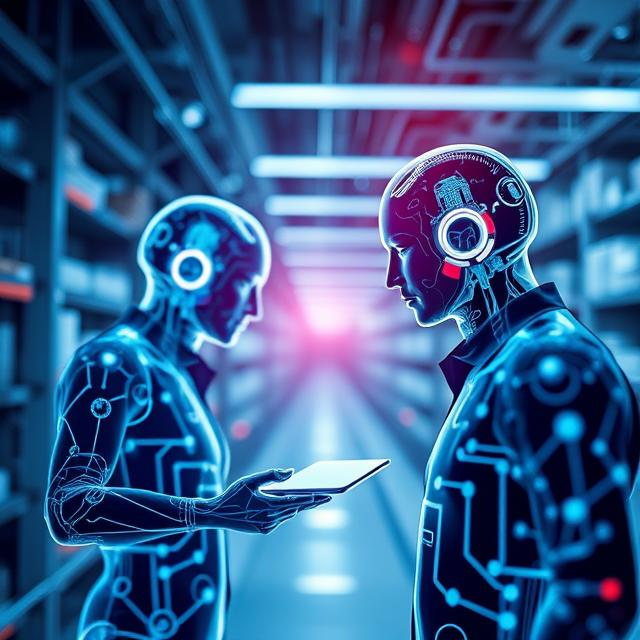Revolutionizing Industries with Digital Twins
In today’s rapidly evolving technological landscape, digital twins are reshaping industries by providing real-time simulations of physical assets, processes, and systems. These virtual replicas allow businesses to optimize performance, predict failures, and streamline operations. Among the key sectors benefiting from this technology, the digital twins supply chain and digital twins in construction are leading the transformation. Their impact on efficiency, cost reduction, and predictive maintenance is revolutionizing business models.
The Role of Digital Twins in Supply Chain Management
Digital twins supply chain helps firms digitalize everything in their supply network, thereby giving them a platform of sorts on which to innovate and integrate IoT data, AI, and cloud computing, businesses can:
- Monitor Real-Time Operations: Gain visibility of inventory levels, shipment tracking, and logistics performance.
- Predict Disruptions: Find risks-generally in areas of supply shortage and transport delays-and mitigate them beforehand.
- Better Decision-Making: Make AI-enhanced analytics work for optimizing procurement strategy and warehousing.
- Improve Sustainability: Minimize waste, use less energy, and enhance eco-friendly supply chain practices.
- Logistics Optimization: Enhancing delivery time and customer satisfaction through real-time shipment and vehicle route tracking.
- Cost Reduction: Through finding inefficiencies and optimizing resources to greatly bring costs down.
- Enhanced Collaboration: Digital twins allow different stakeholders across the supply chain to collaborate seamlessly on one data platform.
Using digital twins, companies can make decisions guided by data to ensure resilience and agility in a convoluted international supply chain ecosystem.
Digital Twins in Construction: A Game Changer
The digital twins in construction sector are experiencing a paradigm shift as this technology enables project managers and engineers to visualize, simulate, and optimize structures before they are built. The key benefits include:
- Enhanced Project Planning: Digital twins afford stakeholders the opportunity to assess design feasibility by presenting a detailed 3D model of buildings, bridges, and infrastructure.
- Risk Prevention: Engineers can be allowed to catch construction issues early giving an opportunity to avert very costly mistakes and risks to safety.
- Real-Time Monitoring: Structures have sensors linked to monitor and report on an ongoing basis their structural health, facilitating predictive maintenance.
- Optimized Resource Allocation: Digital replicas support efficient usage of materials thereby minimizing waste and delays to the project.
- Energy Efficiency: In building projects and infrastructure, smart energy modeling in digital twins reduces energy consumption.
- Increased Productivity: Thanks to digital twins, construction teams can now identify looking bottlenecks later in the construction process and therefore finish their projects in time.
- Cost Savings: Good planning and instant insight will enable companies to save on construction costs while upholding quality standards.
The integration of digital twins can boost productivity, reduce costs, and design smart and sustainable infrastructure in the construction industry.

How Digital Twins Are Transforming Industries and Supply Chains
How Businesses Are Adopting Digital Twins
Across industries, digital twins are rapidly being multiplied for the sake of better performance. Digital twin technology has a lot of interesting use cases, such as:
- Manufacturing: Real-time monitoring of factory equipment with the purpose of minimizing downtime and improving efficiency.
- Healthcare: Simulating patient conditions for the purpose of better personal treatment plans.
- Automotive: Digital twin simulations are used for the optimization of vehicle design and performance.
- Smart Cities: Digital twins help to manage urban infrastructure, traffic flow, and public services.
- Retail and Warehousing: Enabling inventory optimization through real-time data insights linking to the customer experience.
- Aerospace: Aircraft performance simulation and maintenance schedule improvement.
- Oil and Gas: Predicts equipment failures and optimizes the extraction process.
This clearly indicates far-reaching applications of digital twin technology across various sectors.
The Future of Digital Twins in Industries and Supply Chains
As technology evolves, both digital twins supply chain and digital twins in construction will grow more mature. Future possibilities might include:
- AI-Powered Automation: Improvements of machine learning algorithms could lead digital twins to autonomously adjust operations for optimal performance.
- 5G Integration: High-speed data processing will accomplish real-time updates, which will enhance responsiveness and decision-making.
- Blockchain Security: Secure data transactions within supply chains to be transparent and trustworthy.
- Sustainability Initiatives: Enhanced energy savings and waste reduction through smart analytics.
- Cloud-Based Collaboration: Enabling greater access for global teams to collaborate online via digital twin models.
- More Immersive Visualization: Enhance the integration of AR or VR to better engage with digital twin models.
- Regulatory Compliance: Ensuring that industries comply with strict safety and environmental standards.
With these great improvements, it will continue to drive digital twins toward operational efficiencies and innovations across industries.
Digital twins supply chain and digital twins in construction increase efficiency, reduce costs, and optimize operations with real-time monitoring and predictive analytics.
The Future of Web3 and Decentralized Internet Hosting Projects
The Rise of AI personal Assistant Software Siri Alexa Google Home



